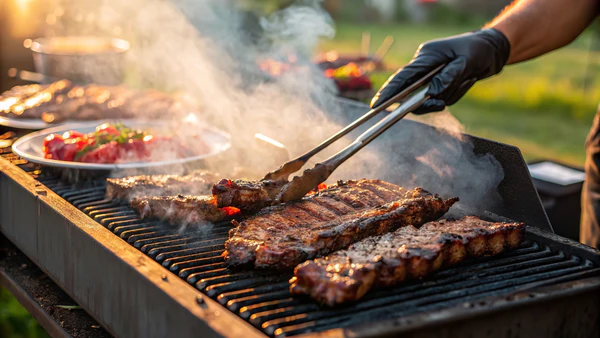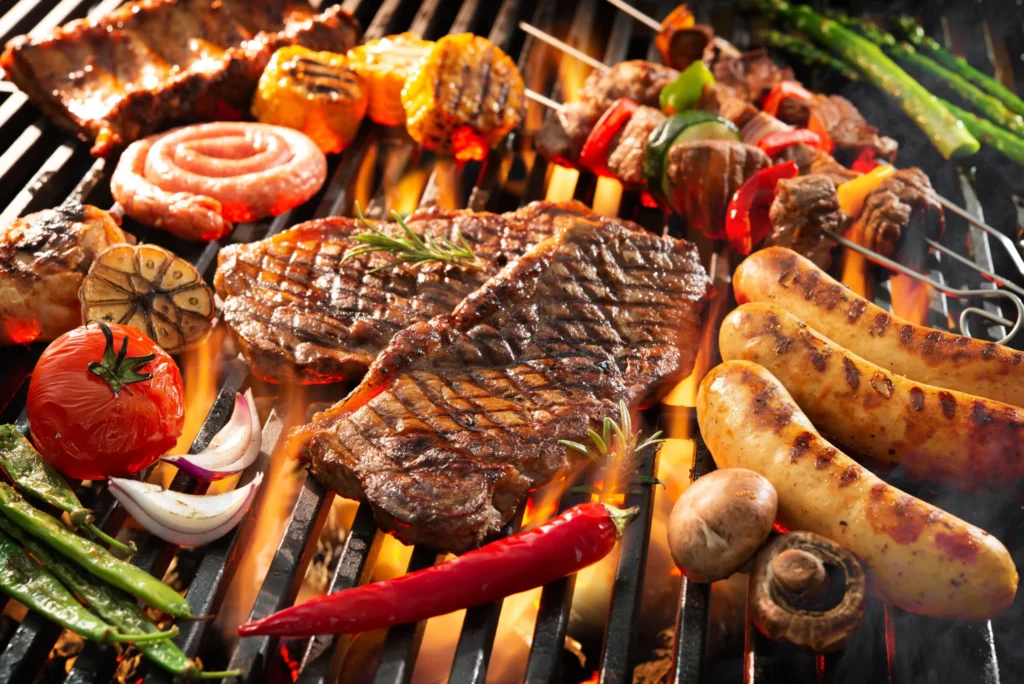
Barbecue has captivated hearts and taste buds for centuries, blending fire, flavor, and fellowship into a cultural phenomenon. In the United States alone, Americans consume over 7 billion chicken wings annually during grilling season, according to the National Chicken Council. But what makes barbecue so irresistibly addictive? It’s the alchemy of low-and-slow cooking that tenderizes tough cuts into melt-in-your-mouth perfection, infused with layers of smoky depth that no stovetop can replicate. As you explore this guide, discover how to harness that primal power, avoid common pitfalls, and create barbecues that aren’t just delicious—they’re legendary.
For those new to the scene, check out our beginner’s grilling essentials to stock your setup. And if you’re craving instant inspiration, jump straight to our top 10 barbecue recipes. Let’s embark on this flavorful journey together.
The Rich, Smoky History of Barbecue: From Ancient Fires to Modern Feasts
Barbecue’s origins trace back to indigenous peoples of the Caribbean and South America, where the Taino word “barbacoa” described a wooden frame for slow-cooking meat over open flames. Spanish explorers brought this method to the mainland, and by the 1500s, it had taken root in the American South. Fast-forward to the 19th century: enslaved African Americans revolutionized the craft, infusing African spices and techniques into what became Southern barbecue. Pitmasters like those in 19th-century Georgia turned whole hogs into communal events, fostering bonds that transcended hardship.
Today, barbecue is a $2.9 billion industry in the U.S., with regional rivalries—think Kansas City’s sweet tomato-based sauces versus Texas’s bold, beef-centric smokes—fueling passionate debates. Yet, its global reach is equally epic. In Australia, the “barbie” is a national obsession, while Argentina’s asado elevates beef to divine status. Understanding this heritage isn’t just trivia; it’s the key to authentic flavor. By honoring these roots, you infuse your cooks with soul-stirring depth.

Delve deeper into American styles with our regional barbecue showdown. For a historical dive, explore Serious Eats’ barbecue timeline, a treasure trove of smoky lore.
This legacy reminds us: barbecue is more than food—it’s a timeless tradition that unites us around the fire.
Evolution of Barbecue Techniques
From open-pit roasts to modern smokers, techniques have evolved dramatically. Early barbecues relied on indirect heat from wood fires, a method still prized for its authentic smoke ring—a pinkish hue signaling perfect low-temp cooking. The 20th century introduced charcoal grills, popularized by post-WWII suburban booms, and gas models for convenience. Now, pellet smokers like those from Traeger blend tech with tradition, automating temperature for foolproof results.
Cultural Impact Worldwide
Barbecue’s influence spans continents, shaping festivals like Memphis in May, which draws 100,000 attendees annually. It’s a vehicle for storytelling, where recipes passed down generations carry family lore.
Essential Barbecue Tools and Equipment: Gear Up for Grilling Glory
No pitmaster succeeds without the right arsenal. Investing in quality tools doesn’t just streamline your process—it unleashes precision that catapults your barbecue from good to god-tier. Start with the grill: charcoal for smoky authenticity, gas for quick starts, or hybrid for versatility. A Weber kettle, iconic since 1952, remains a bestseller for its even heat distribution.
Next, tongs—long, locking stainless steel ones from OXO prevent burns while flipping with finesse. Spatulas with heat-resistant handles slice through burgers effortlessly. Don’t overlook the basting brush for glazing sauces mid-cook, or a digital thermometer like the Thermotron, ensuring meats hit safe internals (165°F for poultry, 145°F for beef).
For wood aficionados, chunks of hickory or mesquite add that irreplaceable kiss of smoke. Chimney starters ignite coals without chemicals, while grill brushes keep grates pristine. Advanced setups? Consider a meat injector for brining briskets or a probe thermometer linked to your phone via Bluetooth.
Budget tip: Assemble a starter kit under $100. Our ultimate barbecue gear checklist details must-haves. For pro reviews, head to Wire cutter’s grill guide.
Armed with these, you’ll grill like a champion, turning every session into a seamless symphony of sizzle.
Must-Have Accessories for Beginners
- Grill Cover: Shields against weather, extending life.
- Drip Pan: Catches fats to prevent flare-ups.
- Gloves: Silicone-lined for 500°F heat resistance.
Upgrading for Pros
Invest in a reverse-flow smoker for competition-level brisket, or infrared burners for searing steaks to caramelized perfection.
Choosing the Right Meat and Ingredients: The Foundation of Flavorful Barbecue
The secret to transcendent barbecue? Starting with stellar ingredients. Prime cuts aren’t just about marbling—they’re about sourcing ethically raised meats that deliver unparalleled tenderness. For ribs, opt for St. Louis-style spares with even fat caps; brisket demands USDA Prime with a thick “deckle” for melt-away magic.
Poultry shines when brined overnight—think spatchcocked chicken absorbing herb-infused saltwater for juicy supremacy. Veggies? Asparagus spears or corn on the cob, charred for smoky sweetness. Sauces elevate: tangy vinegar-based for pulled pork, or thick molasses-laced for ribs.
Season boldly: a rub of paprika, garlic powder, onion, salt, and brown sugar forms a crusty bark. Fresh herbs like rosemary or cilantro add aromatic punch. Pro tip: Dry-age steaks 24 hours in the fridge for intensified umami.
Sustainability matters—choose grass-fed beef from Butche rBox for eco-friendly indulgence. Explore our meat selection guide or All recipes’ ingredient basics.
With these picks, your barbecue becomes a canvas for bold, unforgettable flavors.
Sourcing Tips for Quality
Shop local butchers for custom cuts. For veggies, farmers’ markets yield peak-fresh produce that grills to caramelized glory.
Vegetarian Twists
Portobello mushrooms or halloumi cheese mimic meat’s chew, slathered in BBQ sauce for plant-powered delight.
Mastering Grilling Techniques: Unlock Pro-Level Perfection
Grilling is science meets art—master these techniques, and you’ll command fire like a culinary conqueror. Direct heat sears steaks fast (450-550°F), creating a Maillard reaction for that crave-worthy crust. Indirect? Low-and-slow (225-275°F) for brisket, wrapping in foil at the “stall” (160°F) to push through moisture loss.
The 2-zone method—hot side for browning, cool for finishing—prevents overcooking. Reverse sear: smoke low, then blast high for edge-to-edge pink. For veggies, oil lightly to avoid sticking, and use a basket for smaller pieces.

Wood choice is crucial: oak for mild smoke, apple for fruity notes on pork. Maintain clean vents for airflow control. Rest meats 5-10 minutes post-grill to redistribute juices, transforming dry cuts into succulent stars.
Practice makes postmasters—hone skills with our technique tutorials. For in-depth science, AmazingRibs.com demystifies it all.
These methods don’t just cook; they create barbecue that’s explosively delicious.
Temperature Mastery
Use infrared thermometers for grate temps. Target 130°F internal for rare beef—pull early, carryover cooks it.
Smoke Infusion Hacks
Soak wood in beer for extra flavor layers, or use a smoke tube for gas grills.
Delicious Barbecue Recipes: Sizzling Recipes to Wow Your Crowd
Recipes are the heartbeat of barbecue—here’s a arsenal of crowd-pleasers. Start with Classic Baby Back Ribs: Rub 2 racks with ¼ cup brown sugar, 2 tbsp paprika, 1 tbsp each garlic/onion powder, salt/pepper. Smoke at 225°F for 3 hours, wrap in foil with apple juice, cook 2 more, then sauce and crisp 30 minutes. Serves 4; total time: 5.5 hours. The result? Fall-off-the-bone tenderness with tangy-sweet glaze.
Next, Memphis-Style Pulled Pork: Shoulder (6-8 lbs) slathered in mustard and dry rub (mustard seed, cumin, cayenne). Smoke 1.5 hours/lb until 205°F. Shred, mix with vinegar sauce (apple cider vinegar, ketchup, hot sauce). Pair with slaw for 8 servings.
For quick wins, Grilled Lemon-Herb Chicken: Marinate thighs in olive oil, lemon zest, garlic, oregano 2 hours. Grill direct 6-7 min/side to 165°F. Juicy, zesty perfection for 6.
Veggie star: Charred Corn Salad: Grill ears 10 min, cut kernels, toss with feta, lime, cilantro. Smoky, fresh explosion.
Scale up with our full recipe archive. Get more from Food Network’s BBQ vault.
These dishes don’t just feed—they forge memories.
Advanced Recipe: Smoked Brisket
Trim 12-lb packer, rub with coffee-black pepper blend. Smoke 6 hours bark forms, wrap beef broth, finish to 203°F. Slice against grain—epic, sliceable heaven.
Sides-Integrated Twists
Infuse recipes with global flair, like Korean gochujang on wings.
Perfect Sides and Accompaniments: Complementing Your Barbecue Masterpieces
No barbecue is complete without sides that steal the show. Creamy coleslaw—shredded cabbage, carrots, mayo, vinegar, celery seed—cuts through rich meats with crisp tang. Baked beans simmered in molasses, bacon, and onions bubble into sweet-savory bliss. Grilled corn slathered in chili-lime butter? A smoky, spicy revelation.
Potato salad with mustard vinaigrette adds hearty heft, while watermelon slices grilled briefly offer juicy contrast. For health kicks, quinoa salad with grilled veggies and feta brings nutty freshness.
Balance flavors: acidic pickles tame spice, cornbread soaks up sauces. Our sides recipe roundup has 20+ ideas. For veggie-forward inspo, visit Minimalist Baker.
These accompaniments elevate your spread from solid to spectacular.
Quick Assembly Tips
Prep sides ahead—marinate slaw overnight for deeper crunch.
Barbecue Safety Tips: Grill Smart, Stay Safe
Safety ensures your feasts remain fun, not frantic. Preheat grills 10-15 minutes, checking for gas leaks (soapy water bubbles). Keep a fire extinguisher handy, and never leave unattended. Use long tools to avoid burns; wear closed-toe shoes.
Clean grates with wire brushes post-use to prevent wire ingestion. For kids/pets, zone off the area. Alcohol? Pace it—tipsy flips lead to slips.
Follow FDA guidelines: rest times minimize bacteria. Our safety checklist is printable gold. More from USDA’s grilling safety.
Prioritize safety for worry-free wins.
Common Barbecue Mistakes to Avoid: Sidestep Pitfalls for Perfection
Even pros falter—avoid these to soar. Over-flipping dries meats; once per side suffices. Skipping the rest? Juices flee, leaving toughness. Wrong wood? Pine bitters everything—stick to hardwoods.
Saucing too soon burns sugars; apply last 10 minutes. Crowding the grate steams, not sears—space out. Fix with our mistake-busting guide. [BBQ Pit Boys](https://www.youtube.com/user/BBQ PitBoys) videos nail it visually.

Dodge these, and your barbecues dazzle.
Barbecue Around the World: Global Grilling Inspirations
Barbecue transcends borders, each culture adding unique fire. Argentina’s asado features whole cows on parillas, seasoned simply with chimichurri. Korean BBQ (gogi-gui) sizzles thin beef on table grills, wrapped in lettuce with ssamjang paste.
South Africa’s braai is communal, grilling boerewors sausages over coals with chakalaka relish. Japan’s yakiniku echoes Korean vibes but with wagyu luxury. Mexico’s barbacoa buries meats in pits for earthy tenderness.
Incorporate these: try bulgogi marinade on flank steak. Our international BBQ series explores more. Discover recipes at Saveur’s world BBQ.
Embrace global twists for worldly, wow-worthy plates.
Fusion Ideas
Blend styles: Texas brisket with Korean gochujang glaze for hybrid heat.